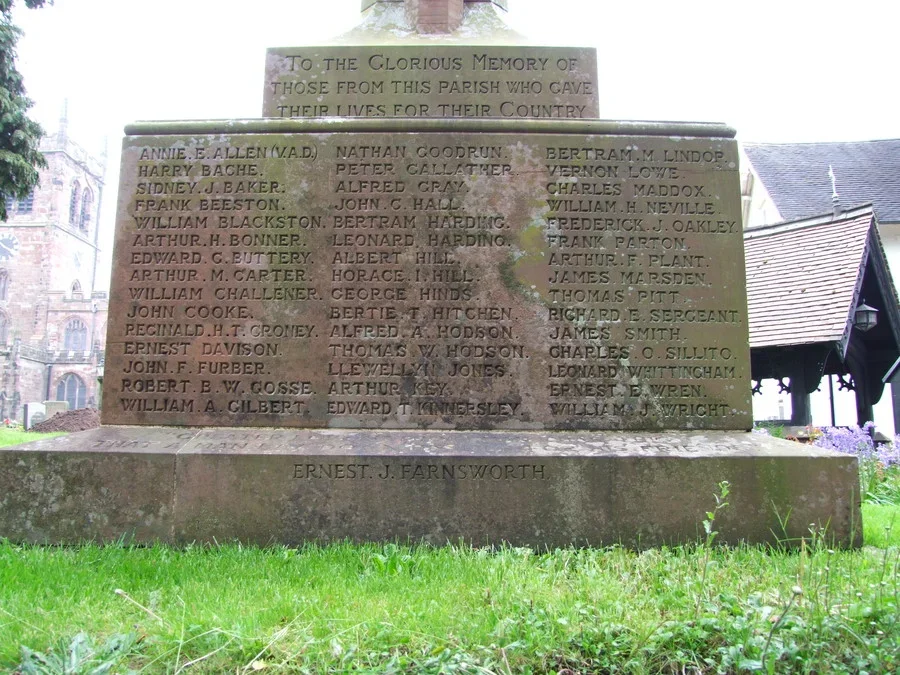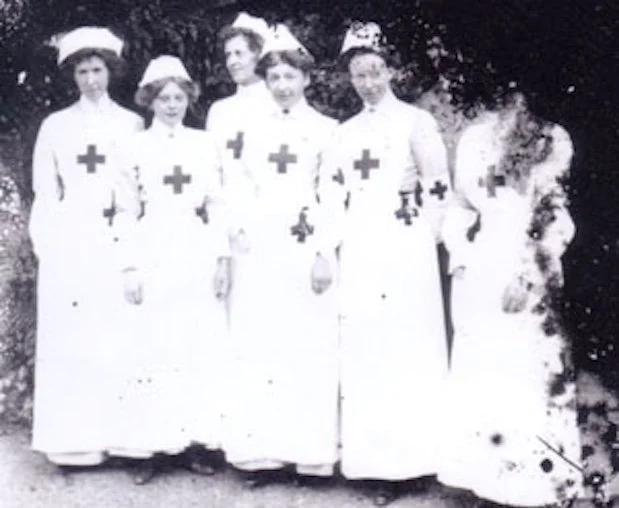Annie E Allen. V.A.D.
Annie Allen V.A.D. commemorated on Ecclehall War Memorial
Eccleshall War Memorial.
As a student of the First World War, I am always interested in the names of the individuals commemorated on war memorials, and it is my custom to read them aloud as an act of remembrance. When I first saw the Eccleshall memorial in Staffordshire, I was surprised to see that the first name inscribed on it was that of a woman, Anne E. Allen VAD, and I immediately wanted to find out more about her. Who was she? Why was a VAD so commemorated? Did she die on active service?
Voluntary Aid Detachments. (VAD). In 1906, as part of the reorganisation of the army and the creation of the Territorial Force, the War Office developed a scheme through which the British Red Cross and the Order of St John of Jerusalem could provide supplementary aid to the Territorial Forces Medical Services. These units were called Voluntary Aid Detachments (VADs), but soon after their formation, the initials VAD started to be used as a nickname to describe the members of the units rather than the unit itself, and the name stuck. Today, these Voluntary Aid Detachments are predominantly viewed as female organisations, and while most members were women, it is also important to remember that many men served, providing essential and valuable services, such as ambulance driving. To become a VAD, a woman had to achieve certification in first aid and home nursing, whereas male VADs only had to obtain a first aid certificate.
The first VADs mainly were upper and middle class women who wanted to do some voluntary work, usually associated with their local hospitals, within a respectable and socially acceptable framework but during the war their role expanded and becoming a VAD was the route by which many sheltered young women swapped the certainties of an Edwardian drawing room for hospital wards full of the mutilated and wounded from the battlefields. Two VADs who became famous in later life, but remained marked by such experiences, were Vera Brittain and Agatha Christie.
World War One. By November 1914, the unexpectedly high casualties had convinced the government that the standard three-year nursing course was insufficient to provide the number of nurses required, and they turned to the voluntary sector. By early 1915, the Joint War Committee of the Red Cross and St John’s had recruited, trained and certificated hundreds of VADs who were to play an essential role in the provision of medical services to wounded servicemen. For VADs serving at home, their most important contribution was raising funds and then providing staff for the dozens, if not hundreds, of auxiliary and convalescent hospitals set up in hotels and country houses to meet the needs of the recovering wounded. Some VADs, usually through family influence, served in the war zones and acted as ward clerks, dressers, etc, to the trained nurses dealing with severe casualties in the forward casualty clearing hospitals.
Eccleshall VAD nurses taken at Trentham Gardens, date unknown. These VADs may have been attached to the small VAD convalescent hospital in Eccleshall, and not the larger Sandon Hospital where Annie Allen served.
Who was Annie Allen? Annie Elizabeth Allen, the 3rd daughter of William Allen, vicar of Eccleshall, 1883-1915 and Prebendary of Sandiacre in the Cathedral of Lichfield. Annie was born on February 5 1872, and was educated at home, but, due to ill health, spent much of her early life abroad. When at home, as far as her health permitted, she was an enthusiastic assistant in her father’s parochial work, and her contributions were widely recognised in the reports of local ‘goings–on’ that appeared in the Staffordshire Advertiser and Staffordshire Chronicle of the period. For example, we find that, with the rest of her family, she helped to raise the funds required to build the new church at Slindon and at the party organised for the villagers after the service of dedication on October 15 1894, the Staffordshire Advertiser noted that Miss A.E. Allen was one of the people who sang at the entertainment.
When war broke out, Annie joined the Red Cross, becoming a VAD. In September 1915, Sandon Hall opened as a Military Convalescent Hospital run by the Sandon and Eccleshall Red Cross, and Annie joined the staff, rising through the ranks to become one of the two Quartermasters.
Sandon Hall, the ancestral home of the Harrowby family. An auxiliary military hospital and Reception Centre in both World Wars.
In her obituary, the Staffordshire Advertiser noted that she was very happy in this work, highly popular with staff and patients, and that during this period, her health had greatly improved. We also know from the local newspapers something of what Annie was doing in the last two weeks of her life. The Advertiser for January 4 1919, reported her involvement in an evening of entertainment held in Eccleshall attended by soldiers from the VAD Red Cross Hospital. On the 18th, the Chronicle carried a report of a supper, followed by presentations and a fancy dress ball, to mark the closure of the Sandon VAD hospital. On this occasion, the Commandant, Miss Parker-Jervis CBE, was presented with a large silver mirror by the officers and sisters past and present, while the VADs, some eighty-four in number, who had worked at the hospital, presented her with a beautiful Red Cross. In her reply, Miss Parker-Jervis said that she had spent some of the happiest years of her life at Sandon and knew that she had the best staff any hospital ever had. Quartermaster Caudler was presented with a pair of silver candlesticks, Quartermaster Allen with a silver frame and Sister Dean with a silver brush, comb and mirror. After the presentations, the dancing commenced, which, as the Advertiser notes, continued until a late hour.
Her Death. Sadly, her next appearance in print is the notification of her death on January 20, 1919, at Sandon Hall Auxiliary Red Cross Hospital. The cause of death was a sudden attack of severe laryngitis, but whether this diagnosis is accurate, we will never know. Young persons sent abroad for their health in late Victorian England usually had a history of respiratory disease. She may have had severe asthma or less likely consumption (tuberculosis), but early 1919 was also the time of the great flu pandemic in Staffordshire, as witnessed by the number of young New Zealanders who lie in the British Military Cemetery on Cannock Chase, and she may have also been a victim.
The Funeral. Annie Allen's funeral was a major event reported in great detail by the press. Her body was brought from Sandon Hall on the afternoon of Wednesday 22nd January to Holy Trinity Church, Eccleshall, the route lined by a large silent crowd. The coffin was place in the aisle where hundreds filed past the flag-draped coffin flanked with an honour guard of VAD nurses. The funeral next day was officiated by no less than four members of the clergy, and the church was packed to overflowing with family, friends and detachments of VADs so that the crowds spilled out to fill the churchyard from where they took part in the singing of the hymns. As the coffin was lowered into the grave the last post was sounded and a Company from the Nottingham and Derby Regiment fired volleys over the grave. There were so many beautiful wreaths that they totally covered the grave and surrounding area.
Annie’s grave is to the left of the church door, next to that of her parents. Unfortunately, the lettering on the stone surround has faded with time, but it is just possible to identify her when the light falls on the faded lettering.
Annie Allen was obviously widely liked and respected throughout the Parish of Eccleshall and the surrounding area, and her funeral, with its military overtones, is quite exceptional for a civilian, even if she was a VAD. Perhaps the sudden death of one so beloved within the community served as a focus for the grief for those who would never return from what, in British terms, remains The Great War of 1914-1918. She is commemorated on the Eccleshall War Memorial, dedicated by the Bishop of Lichfield and the Earl of Dartmouth, the Lord Lieutenant of Staffordshire on September 26 1921, and on the Nurses Memorial in the National Memorial Arboretum dedicated to VADs and Professional Nurses who lost their lives in both world wars.
The Great War Dead of Ecclehall, Staffordshire.
The Nurses Memorial.
Blog Post Title Two
It all begins with an idea.
It all begins with an idea. Maybe you want to launch a business. Maybe you want to turn a hobby into something more. Or maybe you have a creative project to share with the world. Whatever it is, the way you tell your story online can make all the difference.
Don’t worry about sounding professional. Sound like you. There are over 1.5 billion websites out there, but your story is what’s going to separate this one from the rest. If you read the words back and don’t hear your own voice in your head, that’s a good sign you still have more work to do.
Be clear, be confident and don’t overthink it. The beauty of your story is that it’s going to continue to evolve and your site can evolve with it. Your goal should be to make it feel right for right now. Later will take care of itself. It always does.
Blog Post Title Three
It all begins with an idea.
It all begins with an idea. Maybe you want to launch a business. Maybe you want to turn a hobby into something more. Or maybe you have a creative project to share with the world. Whatever it is, the way you tell your story online can make all the difference.
Don’t worry about sounding professional. Sound like you. There are over 1.5 billion websites out there, but your story is what’s going to separate this one from the rest. If you read the words back and don’t hear your own voice in your head, that’s a good sign you still have more work to do.
Be clear, be confident and don’t overthink it. The beauty of your story is that it’s going to continue to evolve and your site can evolve with it. Your goal should be to make it feel right for right now. Later will take care of itself. It always does.
Blog Post Title Four
It all begins with an idea.
It all begins with an idea. Maybe you want to launch a business. Maybe you want to turn a hobby into something more. Or maybe you have a creative project to share with the world. Whatever it is, the way you tell your story online can make all the difference.
Don’t worry about sounding professional. Sound like you. There are over 1.5 billion websites out there, but your story is what’s going to separate this one from the rest. If you read the words back and don’t hear your own voice in your head, that’s a good sign you still have more work to do.
Be clear, be confident and don’t overthink it. The beauty of your story is that it’s going to continue to evolve and your site can evolve with it. Your goal should be to make it feel right for right now. Later will take care of itself. It always does.








